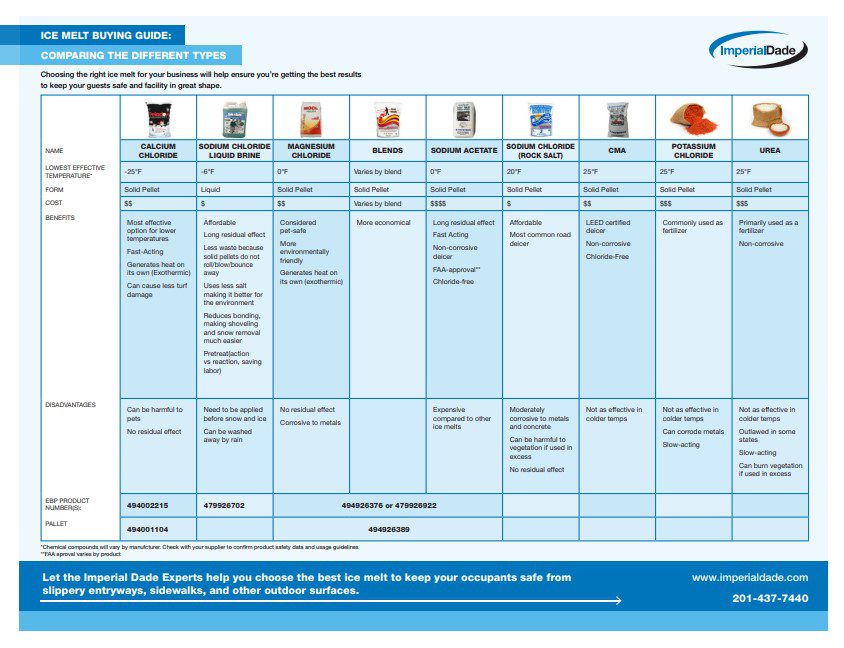For many commercial facilities, the most common way to prepare for snow, ice, and the associated hazards is with ice melt.
While solid ice melt is the traditional, most popular method of snow removal and ice prevention, liquid ice melt is a fairly newer alternative.
Liquid deicer has recently grown in popularity causing many to wonder if they should consider it for their facility.
Like with any product, there are questions about what the item is, how to use it, its effectiveness, and what its advantages and disadvantages are.
To help answer these questions and more, we’ll review everything you need to know about liquid ice melt below.
What is Liquid Ice Melt?
To begin, we’ll start by answering the most common question, “What is liquid ice melt?”
Similar to solid ice melt, liquid ice melt, sometimes referred to as liquid deicer, is used primarily to prevent the build-up of snow and ice, lowering the risk of slippery surfaces and other hazardous conditions during the winter months.
So, now you are probably asking, “What’s the difference between solid ice melt and liquid ice melt?”
Yes, solid ice melt comes in the form of hard pellets, and liquid is a brine.
So, besides the obvious, liquid ice melt is most effective when used as a pretreatment, or in other words, liquid deicer is best used BEFORE a winter weather event whereas solid can be used at any time.
Everything you need to know about ice melt including how to select the best one for your facility based on surface type, lowest effective melting temperature, & more!

What is Liquid Ice Melt Made of?
Like solid ice melt, liquid deicers can be derived from various compounds.
The most common liquid ice melt is sodium chloride liquid brine.
This brine is typically a solution of about ¾ parts water and ¼ part sodium (salt).
When to Use Liquid Ice Melt vs Solid Ice Melt
Liquid ice melt is designed to be used as a proactive, preemptive approach to snow and ice management.
The product comes as a liquid brine and as it dries it leaves behind a coating of dry salt that immediately reacts with snowfall to prevent snow and ice from bonding to sidewalks, parking garages and other surfaces.
While it can be applied during or after a storm, it is not as effective and will deice at a much slower rate than solid ice melt applied when snow and ice are already on the ground.
On the other hand, solid ice melt works by absorbing moisture in the air, from snow and ice, allowing the pellets to create that brine which eventually permeates, and helps soften or prevent the bond between the snow or ice and the ground surface.
Solid ice melt is equally effective when applied before, during, and after a snow event.
How is Liquid Ice Melt Applied?
Similar to solid ice melt, liquid ice melt can be used on roadways, sidewalks, near entryways, in parking garages, and other places where snow and ice build-up pose a hazard.


Depending on the size of the area, it can be applied with either a pump up or backpack sprayer or tanker truck.
Solid Ice Melt vs Liquid Ice Melt
As you probably know, there are several different types of solid ice melt compounds, ranging from rock salt and magnesium to urea and calcium chloride.
The chemical makeup of an ice melt gives the deicer its desired properties such as the ability to be effective in extremely cold temperatures, like -25 F, or provide speedy response times.
To learn more about the different types of solid ice melt, as well as their advantages and disadvantages check out our ice melt comparison guide:
{{cta(‘c1efb4f1-422f-4009-93b1-47d3d6c60b0d’)}}
While each type of solid ice melt has its own range of advantages and disadvantages, as well as specific use cases depending on its chemical makeup, we’ll point out the major advantages and disadvantages of liquid deicer when compared to solid pellets.
Advantages of Liquid Ice Melt
Proactive Approach
Liquid ice melt is a proactive approach, and often considered a pretreatment. As mentioned earlier, liquids work by preventing snow and ice from sticking to concrete and pavement. They work best when applied a few hours before a snowfall.
This enables you to prepare in advance of a snowstorm.
More Environmentally Friendly
When compared to rock salt, liquid ice melt uses significantly less salt, making it better for the environment.
Additionally, there is less waste. Unlike solid pellets, liquid deicer dries to the surface it is applied to. It does not roll or blow away in the wind, with passing cars, or after foot traffic.
Liquid brines are also easier to control because the application is controlled. With pellets, they are thrown around and not contained.
Less Likely to be Tracked Indoors


Many facilities apply ice melt on sidewalks and throughout parking garages to limit the risk of slips and falls due to ice. Unfortunately, while solid ice melt helps protect occupants, it is often brought into buildings on the bottom of people’s shoes, damaging floors.
With liquid ice melt, because the solution dries to the surface, it dramatically decreases the amount of ice melt that makes it past entryway matting.
Prevents Ice From Bonding to the Surface
Pretreating with liquid brine greatly decreases the chances of snow or ice sticking to the pavement or other surfaces, reducing the risk of slippery, dangerous conditions.
Solid ice melt is better for breaking the bond once snow and ice have fallen or formed.
Allows For Easier Snow Removal
Given that the brine prevents bonding, pretreating makes for easier snow removal, lowering the amount of time and effort it takes to clear roadways or walkways.
Long Residual Effect
Liquid ice melts typically provide longer residual action because they continue as brines for an increased amount of time when compared to solid ice melt.
Residual action is the amount of time that the ice melt continues to provide de-icing action after being applied.
Ice melts with longer residual action will reduce the frequency in which ice melt will need to be applied in the future, saving on the amount of ice melt used and the labor needed to apply the ice melt.
Disadvantages of Liquid Ice Melt
Less Effective During and After Snowfall
Although it is a great source for preemptive ice control, liquid ice melt is not as effective as solid ice melt when applied after a snowstorm.
When applied during or after a snowstorm, it takes longer than solid pellets to melt snow which can be dangerous.
Not Effective if Applied Too Early
Liquid ice melt should only be applied as early as 48 hours in advance.
If it is applied too early, the product can be washed or worn away, rendering it ineffective.
Can Be Washed Away by Rain and is Not Effective For Use With Freezing Rain
Liquid ice melt should not be used if there is rain or freezing rain predicted before or during the winter event you are preparing for.
Rain will wash away the liquid ice melt that has been applied to the surface. This includes forecasted freezing rain that is anticipated before or during a snowstorm.
Not Effective During Heavy Snowfall
Liquid decider should not be used with heavy snowfall. Although it will eventually break down snow and ice in an area, it will take much longer to deice than solid ice melts.
Final Thoughts
If you are debating whether liquid ice melt or solid ice melt is the best for your business, it will likely be a combination of both.
Liquid ice melt is a great preventative but it should be followed up with solid deicer during and after a snowfall for enhanced safety.
It is vital to remember that a liquid deicer is most effective before a snow event and only effective in certain conditions.
Imperial Dade locations have a variety of solid and liquid ice melt to keep the people in your building safe during the winter. If you’re located in the United States or Canada, contact a specialist for help deciding the best ice melt for your facility.
For a more detailed comparison of the different types of ice melts, check out our other article which compares the most popular types of solid ice melts, reviews how to choose the best one for your needs, and outlines the typical cost of each. You’ll also get the chance to download our one-page comparison guide!
What is Ice Melt? Selecting The Best Ice Melt For Your Facility
